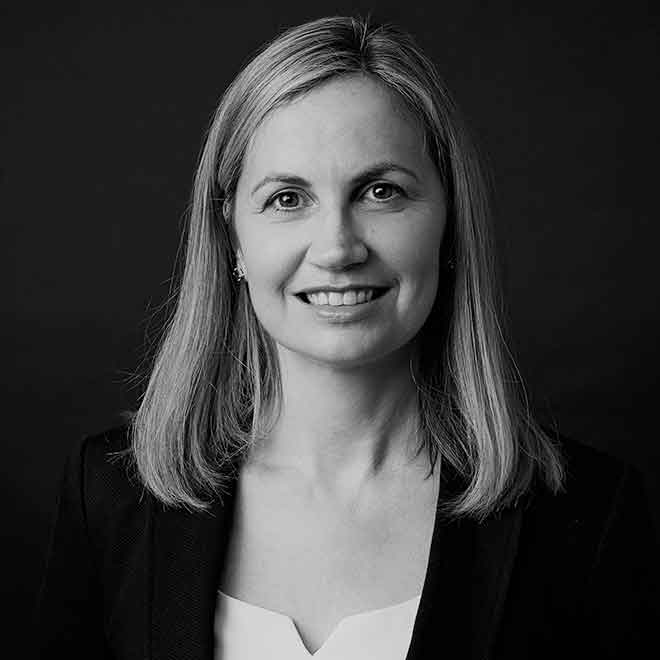Q&A: From the Court room to the lounge room: Advocacy in the virtual world

Xuelin Teo practises in commercial law. She is currently representing Toyota Motor Corporation Australia in the DPF class action.
Julie Granger has expertise in complex and high-value disputes relating to commercial contracts, and particular experience in regulatory matters relating to the Superannuation sector. She is currently acting for the Receivers and appointing banks in relation to the collapse of Dick Smith Electronics.
Christine Melis practises in public law and commercial law, with a specialisation in inquests and commissions of inquiry. She has appeared in a number of high-profile matters including the Lindt Cafe Siege Inquest on behalf of the NSW Police Force and the Victorian Bushfires Royal Commission on behalf of the State of Victoria.
Elizabeth Bishop practises in Federal and State taxation law, administrative law, equity and trust law, property and general commercial disputes. Notable matters include the High Court case Bruton Holdings Pty Ltd (in liquidation) v Commissioner of Taxation, the long-running Oswal v Commissioner of Taxation litigation, and in The Commissioner of the Australian Federal Police v Cranston.
Question 1: What has been the most challenging aspect of moving to virtual hearings?
Xuelin Teo: Not having the opportunity of discussing issues with opponents immediately prior to hearing, as one would usually engage in at the door of a physical courtroom. Those conversations can resolve disputes and shorten the hearing time. To address this issue, I tend to converse with opposing counsel well ahead of a virtual hearing, mindful that instructions can take time, to try to narrow the issues in dispute during the hearing.
Julie Granger: For the most part, the move to virtual hearings has not proved difficult. However, with any change comes challenges. The most challenging aspects would include use of the various types of technology as different Courts/hearings have utilised different platforms and getting used to a new set of protocols or processes. The other challenging aspect is that it can be harder to decipher a Judge’s or witnesses’ non-verbal cues in a virtual environment.
Christine Melis: Initially, the most challenging aspect was acquiring and downloading the various IT platforms required to support a virtual environment and then ensuring they worked on different devices. There are a number of platforms that, prior to the pandemic, I had never had reason to use. All of a sudden, I needed to become familiar with all of them. The great thing is the various apps allow for communication not only for virtual hearings, but also conferences and for communications with solicitors, clients and members of chambers.
Elizabeth Bishop: By far the greatest challenge to me in moving to virtual hearings has been the loss of “theatre” in the trial. The screen diminishes the ability to engage with the judge with the same effectiveness otherwise available in a face to face hearing, particularly when cross-examining a witness where you try to gauge not just the answers to questions but the reactions from the bench. Further impacting this is the lag time and drop-outs with technology that occur fairly frequently. It has certainly taken some of the gloss off what we do as advocates and I have had to learn how to try to bridge the gaps caused by not being physically present in the location.
Question 2: How have you successfully managed communication with your clients throughout a trial?
Xuelin Teo: Gone are the days of passing post-it notes across the Bar table and giving a subtle look that says “is there anything else you’d like me to add”.
To promote instantaneous feedback and instructions, set up a group chatroom ahead of a hearing (eg WhatsApp). Ask for a short adjournment to seek instructions if a curly question warrants, or if appropriate to check that all client instructions have been addressed during the hearing.
Julie Granger: I have typically used regular Zoom meetings (or conference calls when instructions are urgently required). In some cases it has still been possible to obtain instructions in person, with appropriate social distancing of course.
Christine Melis: Open lines of communication with clients is a must. Regular telephone calls and emails with the client, both during a trial and during court adjournments, have proven necessary to facilitate the taking of timely instructions and discussions around strategy and evidence. The means of communication and the person with whom you will be communicating, who has authority to give instructions, needs to be determined early to avoid any confusion or delays.
Elizabeth Bishop: WhatsApp and the messaging feature on Microsoft Teams have been useful tools for communicating with clients but its success has depended heavily on their (and my) ability to use the technology, and also the ability to be checking messages at the same time as engaging with the screens to watch the trial (which is harder!). With a virtual courtroom it is even more important to ensure the lines of communication work effectively, whichever method is employed. On occasions, this has meant that I have had to request a short adjournment to have a discussion with the solicitor and client. The judges have been willing to accommodate this.

Xuelin Teo, Barrister
Tel +61 3 9225 7113
[email protected]
Profile

Julie Granger, Barrister
Tel +61 2 8224 3034
[email protected]
Profile

Christine Melis, Barrister
Tel: +61 2 8998 8735
[email protected]
Profile

Elizabeth Bishop, Barrister
Tel +61 2 9230 3263
[email protected]
Profile
Question 3: How have you managed the engagement of witnesses and virtual cross-examination?
Xuelin Teo: Ahead of a hearing, make sure witnesses have the basic tools during the hearing – a stable internet connection, their affidavit or witness statement and the court book. A quiet space without distractions is also imperative. Forewarn your witness about what could go wrong with technology so that they are not thrown off if such problems arise.
Julie Granger: Virtual cross-examination is not new, but it does have its nuances in terms of process, the nature and effectiveness of cross-examination. I find that witnesses who are giving evidence virtually need more preparation in terms of how they are to give evidence.
The theatrics that some Counsel employ during cross-examination are also of lessor impact on a witness when the evidence is given virtually.
Whilst there may be benefits of evidence being given virtually, there are also disadvantages – perhaps most importantly, non-verbal cues can be missed.
Christine Melis: Tone, pace and an advocate’s tools of persuasion are vital to a successful virtual presence. To engage on screen is far more difficult than in person. You will lose the attention of a judge or witness with a monotone, speaking quickly, diverting your eyes from screen or displaying distractions in your background.
I have found the following tips, specific to appearing on screen, very useful in managing the engagement of witnesses and judges. Some of them were reinforced in some recent training I undertook with NIDA:
- Have a blank canvas behind you
- Centre your face on the screen so that there is only a small space between the top of your head and the top of the screen
- Look into the camera when addressing the court
- Consider lighting. It may be worth investing in some lamps/lights that will illuminate you on screen
- Don’t abandon hand gestures entirely; in fact, properly used, "close to heart gestures" are said to inspire greater belief in what is being spoken
- Breathe
- A virtual hearing can be more tiring than in-person. It is important to acknowledge this and pace yourself. Keep your energy levels somewhere between "neutral" and "alert".
Elizabeth Bishop: Diminished (but not altogether lost) in the process of the virtual courtroom is the ability to accurately assess a witness’ physical responses to certain questions (particularly where credit is in issue) and a judge’s engagement with the cross-examination.
When there are numerous documents to show a witness the process is even more protracted and requires both counsel and solicitors to be even more prepared in the lead up to the hearing, but also in keeping a record of which document was put before the witness at any given moment. Without the precise notetaking of my solicitor it may have been impossible to reconstruct what had occurred.
Question 4: What has surprised you about the transition to virtual hearings?
Xuelin Teo: I have been struck by the lightning speed at which courts and participants have adapted to the new virtual world. Some aspects of the style and nature of effective advocacy has also changed. On occasion, judges have been more relaxed – many an appearance has not gone without a joke being passed by a judge, or an observation made about their surrounds.
Julie Granger: The willingness of so many in the profession to adapt. When the Courts first moved towards virtual hearings, a number of hearings I was involved in were adjourned or hearing dates were not imposed due to a reluctance to have the matter dealt with virtually. However, as time has gone on, Courts and practitioners have become more comfortable with virtual hearings or hybrid hearings where a limited number of people are in Court and others are joining virtually so as to ensure social distancing in the courtroom.
Christine Melis: I believe the impact of the transition to virtual hearings has been overwhelmingly positive. I was surprised at just how quickly the courts and the profession adapted. Even now, some 7 months of running matters virtually, technical glitches arise – whatever the glitch, you just have to be ready to troubleshoot quickly.
Elizabeth Bishop: I have been amazed at how quickly my solicitors and clients have adapted to the changes brought about by virtual hearings. Legal representatives as well as the Courts and Tribunals have worked very hard to overcome technological challenges. By far what has surprised me the most is just how much I miss being present in a physical court room with court staff, counsel, solicitors, spectators all buzzing in the judge’s redoubtable presence.
Question 5: What are your predictions for how our Court processes may adapt in the future?
Xuelin Teo: Virtual hearings have brought about some efficiencies to court processes. For example, not waiting outside the courtroom until a matter is called, not having to travel to and from a courtroom, and witnesses giving evidence by video link without the need for an application supported by affidavit.
These are some of the conveniences which will, in my view, invariably result in a far greater number of interlocutory and final hearings being conducted virtually.
The corollary is that in-person engagement with colleagues (clients, solicitors, other barristers) and some formality associated with in-person hearings will fall away. I expect that superior courts will try to find a balance between both – being in a physical courtroom and virtual hearings. But the onus will shift, so that courts will have to be persuaded about why a hearing ought to take place in person rather than virtually.
Julie Granger: I suspect that Judges may be more willing to accommodate practitioners participating in a court hearing virtually, upon request. Having said that though, I (and many of my colleagues who I speak to) prefer hearings in person rather than virtual hearings and I don’t expect that preference to be altered by current experience
Christine Melis: There is no doubt that the pandemic has demonstrated that courts and the profession can adapt, and adapt quickly, to a virtual environment. I would hate to think that the courts and workplaces will totally abandon the gains offered by the virtual setting. My hope is that courts will continue to embrace virtual hearings, at least sometimes.
My other hope is that the virtual setting will open up Australia’s borders with solicitors and barristers appearing in matters cross-jurisdictionally. Individually and separately, State Bars and legal professions are strong but as a truly national profession, we are a force to be reckoned with. Opening up the profession to a greater pool of talent, expertise and knowledge, is exciting and made possible through virtual mediums. We should embrace this opportunity and feel optimistic about what the future holds for our profession.
Elizabeth Bishop: Conducting virtual directions hearings and interlocutory applications is something I think the Courts and Tribunals are likely to continue. Generally, they have been much quicker and also very convenient to attend.